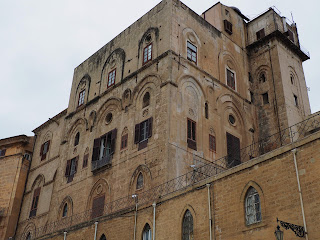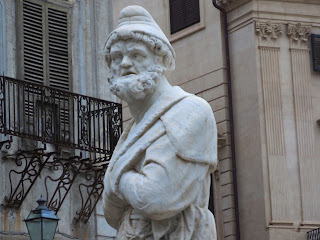Palermo, the largest city in Sicily, has a reputation for being a crazy place to try and get around. It also has a wealth of history, architecture and art so was something we definitely wanted to see. We decided the best way was to hire a guide, drive into the outskirts, be met and taken around. Our guide, Marco, (whom we found through Tour HQ, our favorite resource for identifying local, independent guides), was very responsive and helpful, not to mention a wealth of information. We decided to divide our visit into two separate trips. The first visit focused on the sites.
Palermo, although having the same antecedents as virtually every significant community in Sicily, was not a major community until the Islamic conquest of the 9th century AD. They built Palermo up and made it their capital. When the Normans came and conquered, they too focused their capital on Palermo. Since then through all the various dynasties and national rulers that have controlled Sicily, Palermo has been the capital.
The Norman rule period in Sicily was actually very short - only about a century or so. Yet it left a lasting influence because it was a brief time when major cultural groups (who elsewhere were bashing each others brains out) were living in somewhat ecumenical harmony.
“For the first, and indeed the last, time in European history, the
three great civilizations of the Mediterranean, the Latin, the Greek and
the Arabic all came together in harmony and concur. And all this
occurred less than a hundred years after the schism between the Greek
and the Latin churches, and in the very century of the second and third
crusades, where just a few hundred miles to the East Christians and
Muslims were bashing each other’s brains out. Only here, in this one
island, in the dead centre of the Mediterranean, was there peace,
understanding and mutual respect. Norman Sicily remains a lesson to us
all.”
John Julius Norwich
For the city of Palermo and its surroundings, this led to a highly unique form of artistic expression that combined elements from the three civilizations. We shall explore this photographically.
We rendezvoused at a car park right on the outskirts of town close to where Marco lives. We caught a bus to the Central Station and then took a train to our first stop, the Royal Palace.
This was once one of the gates in the city walls. It commemorates the reconquest of Sicily from the Muslims
Part of what of what is good and bad in Palermo is the rewriting of history via art...meaning each new ruler felt the need to put their mark on the city by building over or changing what already was there. This is true of most of the major monuments and is true of the Royal Palace.
This is one section that goes back to the Norman-Arab style of Roger II, THE key figure during this period.
The 'must see' section of the Palace is the Cappella Palatina, Palatine Chapel. It is an amazing example of the Norman-Arab style that combined Greek Byzantine, Roman Gothic and Arab Muslim influences.
We enter the Royal Palace after seeing a beautiful example of 21st century renovation scaffolding.
Then into a courtyard and onto the Chapel
The Overview
I felt that still pictures could not give you the full feel of the size, breath, and complexity of this and other structures we saw. So I made use of video instead.
Readers know my love of mosaic art and my great appreciation for the skill of the Byzantines. I discussed this earlier in my post on the Villa Romana and I compared the classic Roman Empire to the early Byzantine period 300 years later as demonstrated at Ravenna.The Cappella Palatina represents the very end of that period, 600 years following the work in Ravenna.
I always wonder who the actual people were that the artists used as the model for there representations. Clearly they are not just dreaming these up.
I like the way this one's eyes are vacant unlike any of the others
And these two are such interesting characters
The Islamic influence is seen in the geometric art form plus the unique ceiling
A walk through a garden where we saw a 'strangling ficus' which is in the process of overcoming a fellow tree. It will take a while but the ficus will prevail
Next we were on to the Cathedral, another example of multiple eras architectural styles in a single building.
Here are examples of the oldest section with their Western Gothic and Islamic combination.
The inside of the Cathedral has been done over so many times according to Marco that it has become almost completely blank. Nonetheless there were a few interesting touches.
This seems like just a simple column.
Until it is pointed out it has a verse from the Koran on it!













































2 comments:
glad you loved Palermo!
Definitely looks like it is worth the effort to see the city!
If I were in construction, I would consider modern, safe scaffolding to be beautiful.
Post a Comment